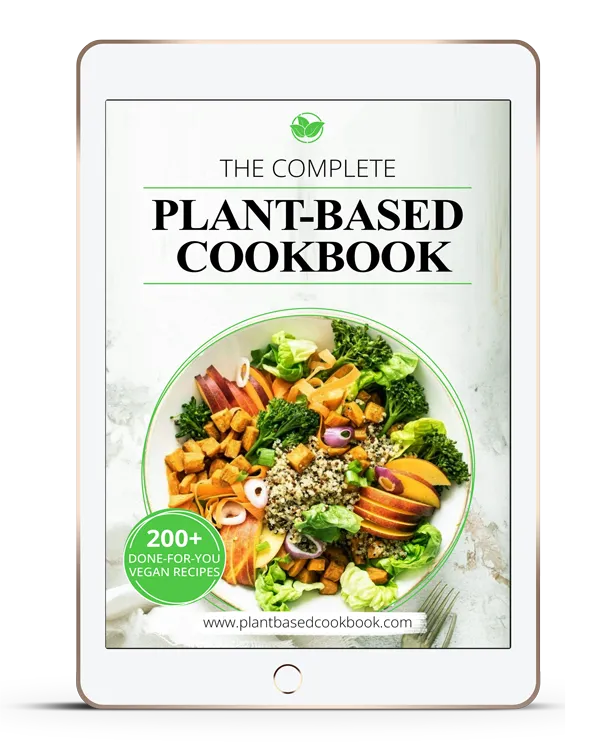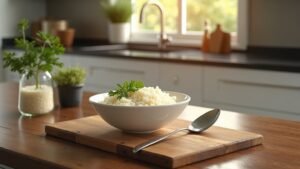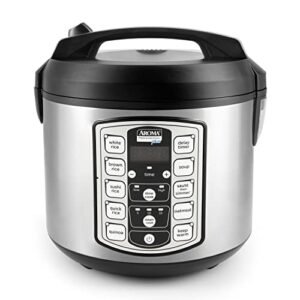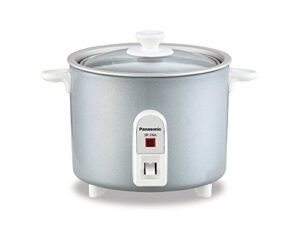Cooking rice in clay pot cookers allows us to experience a time-honored tradition that brings out rich flavors. These pots are valued for their ability to distribute heat evenly, resulting in perfectly fluffy rice.
By cooking slowly, they prevent burning and help us stay connected to culinary customs. The clay material enhances the natural essence of dishes, whether it's grains, soups, stews, or even delicate custards.
Beyond rice, these versatile pots can be used for various cooking tasks like steaming vegetables and fermenting yogurt. Learning how to select and care for these cookers can introduce us to a world of culinary joys.
Let's delve deeper into these advantages.
Table of Contents
ToggleBenefits of Clay Pot Rice Cookers
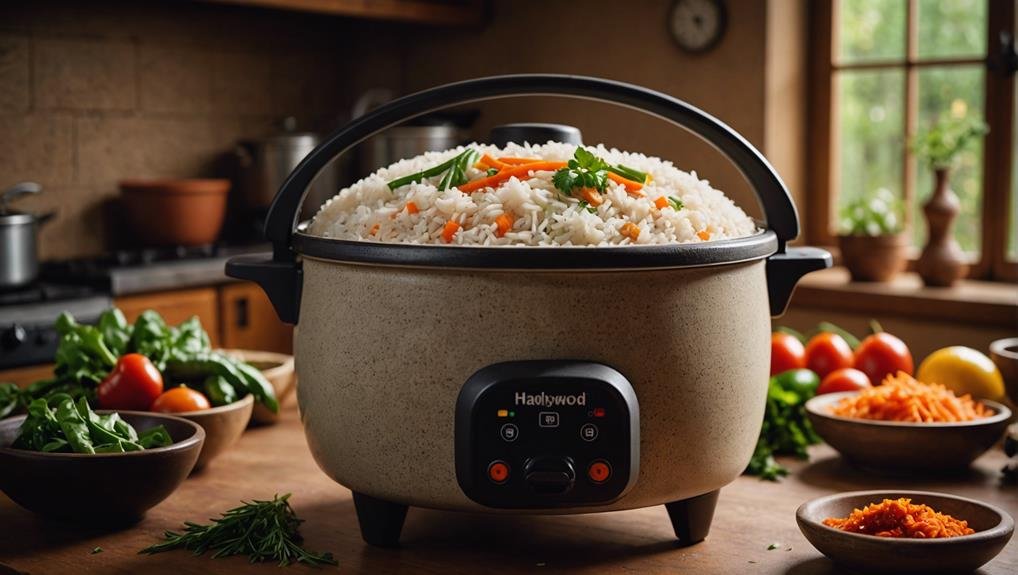
Clay pot rice cookers excel in slowly cooking rice to perfection, resulting in a fluffy texture and delicious taste. These cookers employ traditional techniques refined over centuries, ensuring each grain absorbs moisture evenly. The gradual cooking process enhances the natural flavors of the rice, offering a delightful dining experience.
The clay pot's heat conductivity is crucial in this process, preventing burning or uneven cooking. This consistent heating guarantees uniform cooking from top to bottom. In addition to rice, these cookers are versatile, allowing for the preparation of hotpot dishes or steamed vegetables, making them indispensable in the kitchen.
Compact and easy to handle, clay pot rice cookers seamlessly fit into any culinary space. Designs like the Kamacco from Tsukamoto Pottery combine modern aesthetics with traditional craftsmanship, offering both functionality and a touch of cultural heritage.
How They Work
Clay pot rice cookers harness the heat-conducting properties of clay to cook rice evenly, resulting in tender and flavorful grains. The clay's moisture retention elevates the rice's taste, providing a gourmet dining experience at home.
The slow cooking process in a clay rice cooker is essential for achieving perfect results. The clay material evenly distributes heat, preventing burning or uneven cooking, while the double lids maintain ideal heat and moisture levels for fluffy, well-cooked rice.
The features of a clay rice cooker work together harmoniously:
- the clay material conducts heat evenly, ensuring tender grains;
- the moisture retention keeps the rice moist and enhances flavors;
- the double lids retain heat and moisture for perfectly cooked rice; and
- the versatility allows for cooking various dishes beyond just rice.
Choosing the Right Cooker
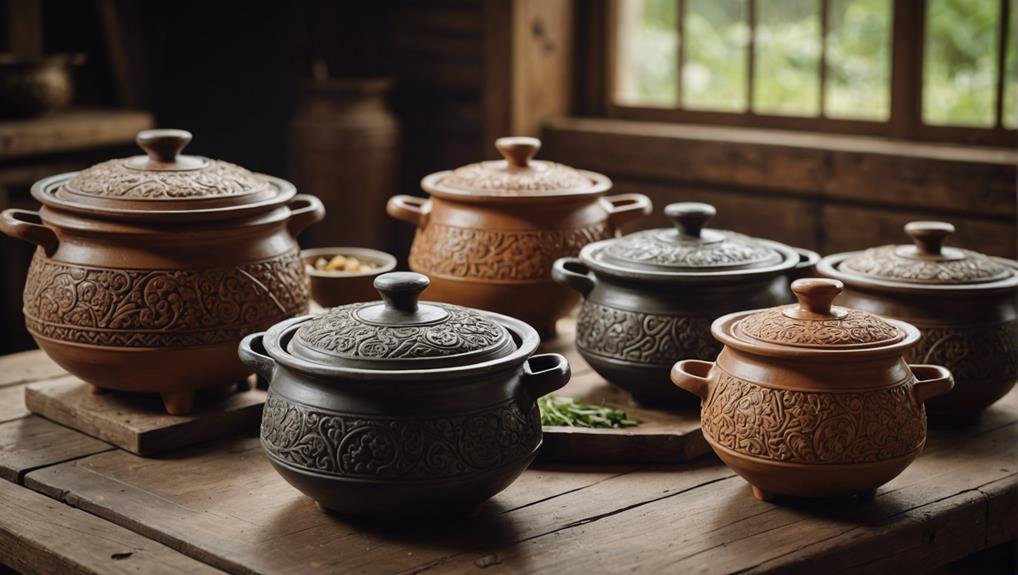
When picking out the perfect clay pot rice cooker, it's crucial to consider the capacity that suits your family's needs and the special features that enhance traditional cooking methods. Whether you're cooking for a small household or a large gathering, you can find options ranging from 1-2 servings to family-sized models.
One outstanding feature to keep an eye out for is double-lidded donabe clay pots. These ensure slow, even cooking, resulting in perfectly fluffy rice every time.
Another important factor is versatility in design; a compact size allows for easy storage, while additional lids can make the clay cooker multi-functional.
It's worth delving into the brand story, like with VitaClay Best Clay Cookers, to gain insight into the heritage and quality of the product. Brands that blend traditional techniques with modern designs often offer top-notch performance and cultural authenticity.
Lastly, don't forget about care instructions. Most clay cookers require hand washing and are suitable for gas stoves but should be kept away from induction stoves and microwaves.
Preparing the Clay Pot
Now that we've picked out the ideal clay pot rice cooker, let's get it ready for cooking to ensure delicious traditional flavors in our meals.
Start by soaking the VitaClay Best Clay Pot in water for at least 15 minutes to prevent cracking while cooking.
After soaking, it's important to season the pot. Apply a thin layer of oil to the inside and bake it in the oven at a low temperature for 30 minutes. This step helps create a natural non-stick surface, enhancing the taste of our dishes and prolonging the lifespan of the cooker.
When using the clay pot on the stovetop, always use a heat diffuser to distribute heat evenly and avoid hot spots that could damage the pot. Remember to avoid sudden temperature changes, such as placing a hot pot in cold water, as this can lead to cracks.
For cleaning, simply use warm water and a soft sponge to preserve the pot's natural properties. Avoid using harsh chemicals or abrasive scrubbers.
Cooking Perfect Rice
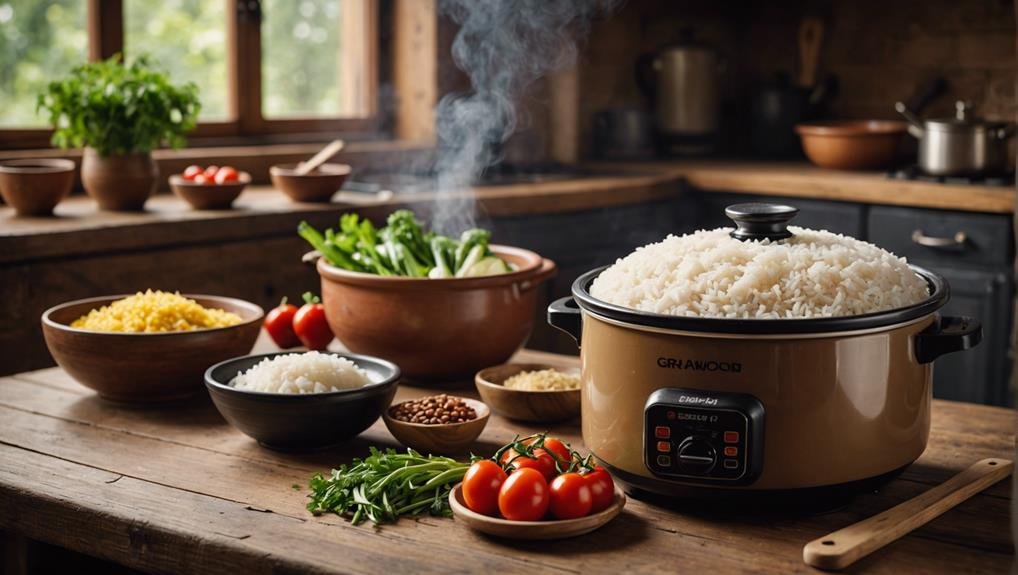
To cook perfect rice in our clay pot rice cooker, start by measuring the rice and water accurately. The right ratio of rice to water is crucial, usually around 1 cup of rice to 1.5 cups of water, but it can vary based on the rice type.
Once measured, put the ingredients in the clay pot. The unique double-lidded design ensures gradual heat conduction for even cooking.
Unlike modern slow cookers, the clay pot infuses the rice with a natural, earthy flavor, enhancing its taste. Bring the water to a boil, then lower the heat to simmer, allowing the rice to cook slowly to achieve a fluffy texture.
This method not only cooks the rice perfectly but also connects us to a rich culinary tradition.
Tsukamoto Pottery offers high-quality clay pot rice cookers that blend traditional techniques with modern designs, ensuring an authentic and efficient cooking experience.
Recipes to Try
Let's discover some delicious recipes that show off the amazing cooking abilities of our clay pot rice cookers. Whether you're using a VitaClay or Tsukamoto Pottery cooker, the double-lidded design ensures perfect texture and even cooking every time.
One classic dish to try is Clay Pot Chicken Rice. Simply marinate chicken in soy sauce, ginger, and garlic, then layer it over washed rice in the clay pot. Add water or broth, and let the flavors meld together as it cooks. The result is a savory and aromatic meal that's sure to impress.
Another great option is a Vegetable Hotpot. Layer a variety of vegetables like bok choy, mushrooms, and carrots in the clay pot, and add tofu for protein. Pour in miso or vegetable broth, and let the pot work its magic. The slow, even cooking process ensures that the vegetables turn out tender and full of flavor.
For a sweet ending, consider making Coconut Milk Sticky Rice. Cook sticky rice in the clay pot with coconut milk, sugar, and a touch of salt. The end result is a creamy and slightly sweet dessert that's perfect for any occasion.
These recipes truly showcase the versatility and traditional cooking techniques that our beloved clay pot rice cookers offer.
Maintenance Tips
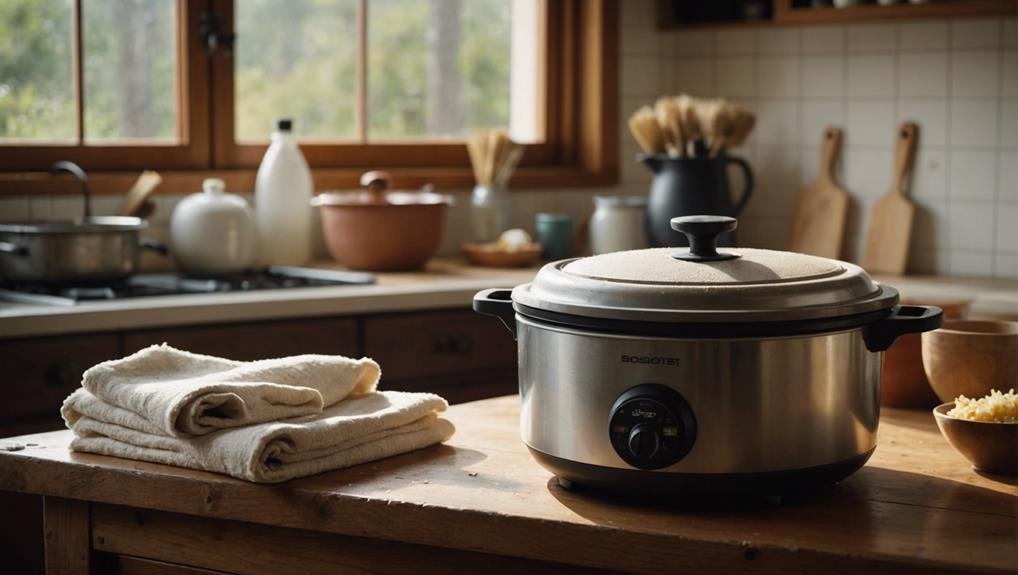
When selecting the right clay pot for cooking rice, it's crucial to handle it with care to maintain its quality and flavor-retention abilities. Steer clear of using metal utensils that can scratch the delicate surface, which might affect the pot's performance over time.
For cleaning, opt for warm water and a soft sponge to preserve the clay's natural flavors and enhance the taste of your dishes. After cleaning, store the clay pot in a cool, dry place to prevent any damage or moisture accumulation that could impact its longevity.
Regularly season the clay pot by soaking it in water for a few hours to prevent cracking and maintain its integrity. Be cautious of sudden temperature changes to avoid thermal shock, allowing the pot to heat up and cool down gradually for its long-term durability.
Common Mistakes
Taking care of your clay pot rice cooker is essential for its longevity, but it's equally important to avoid common mistakes while cooking to ensure perfectly cooked rice.
One common mistake to avoid isn't soaking the rice before cooking. Soaking helps with even cooking and prevents crunchy rice. The unglazed clay pots in the VitaClay® Chef line perform best when following traditional soaking methods.
Another mistake to watch out for is overfilling the pot, which can lead to rice spilling over and messing up the cooking process. Refer to the Recipe Booklet that comes with your Buy VitaClay Best Clay cooker to get the right proportions.
The amount of water you add is crucial. Adding too much or too little water can result in undercooked or mushy rice. Pay close attention to the recommended water measurements for the best results.
Avoid opening the lid frequently while cooking. Each time you lift the lid, you disrupt the cooking process, affecting the texture and flavor of the rice. Practice patience and trust the process.
Lastly, make sure to follow the recommended cooking time and temperature settings to get the best outcome. Consulting a specialist for guidance can also help you achieve top-notch results. While perfection may not be guaranteed, following these tips will definitely improve your rice cooking experience with Vitaclay.
Alternative Uses
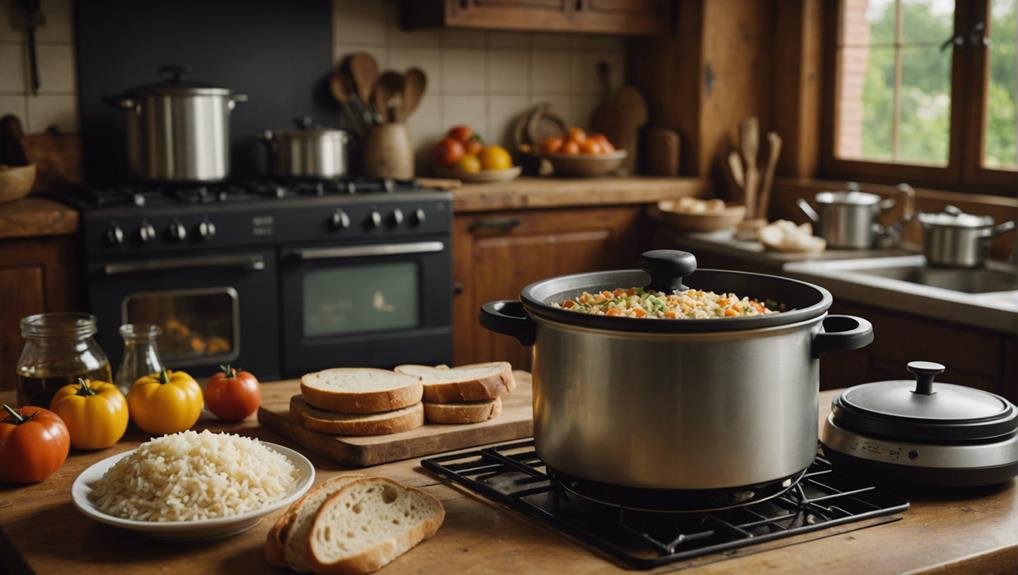
Clay pot rice cookers offer a versatile way to cook a variety of dishes beyond just rice. They excel in making soups, stews, and desserts like rice pudding due to their slow, even cooking process.
When cooking grains like quinoa, barley, and oats in a clay pot, their natural flavors are enhanced, resulting in delightful textures.
The gentle heat distribution of clay pots benefits soups and stews, allowing ingredients to blend harmoniously. Picture a flavorful beef stew or a nutritious vegetable broth, both enriched by the unique properties of clay cooking. These dishes become more flavorful and satisfying thanks to the clay pot's characteristics.
For dessert lovers, clay pots can be used to create creamy custards and rice puddings with a smooth, velvety texture reminiscent of traditional treats. In addition, clay pot rice cookers are perfect for fermenting yogurt or making risotto, as the slow cooking process helps achieve the desired creamy consistency.
Top Brands
With a legacy dating back to 1864, Tsukamoto Pottery has earned its reputation as a top-tier brand in the realm of clay pot rice cookers. For over a century, they've honed their craft, specializing in creating exceptional clay pots that elevate the rice cooking experience.
The standout feature of their collection is the double-lidded donabe, a traditional Japanese cooking vessel renowned for its ability to cook rice slowly and evenly, resulting in perfectly tender and flavorful grains.
A distinguishing factor of Tsukamoto Pottery's rice cookers is their use of Mashiko-ware, known for its robustness and heat retention properties. This material not only enhances the longevity of the clay pots but also ensures superior heat distribution for optimal cooking results.
Despite their traditional roots, these rice cookers are designed with modern convenience in mind, featuring a compact size that's easy to handle and store, catering to the needs of contemporary lifestyles.
What sets Tsukamoto Pottery apart is their innovative approach to design, particularly seen in their versatile lids. The inner lid serves multiple functions, from acting as a cover for rice bowls to doubling up as a measuring cup, adding practicality to the traditional design.
Conclusion
As we delve into the world of clay pot rice cookers, we've discovered their numerous advantages and the importance of selecting and caring for them properly.
Surprisingly, in certain cultures, a staggering 80% of households utilize clay pots for their cooking needs.
This age-old cooking technique not only intensifies the flavors of dishes but also helps us stay connected to our culinary heritage.
Let's embrace these time-honored practices and savor the cultural richness they bring to our meals.
Happy cooking!


